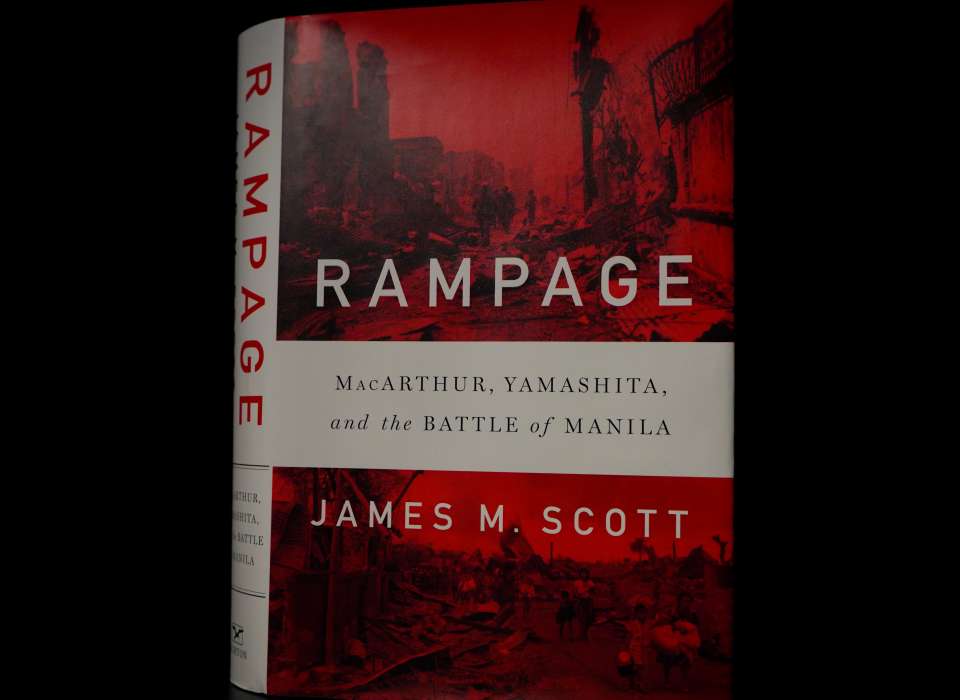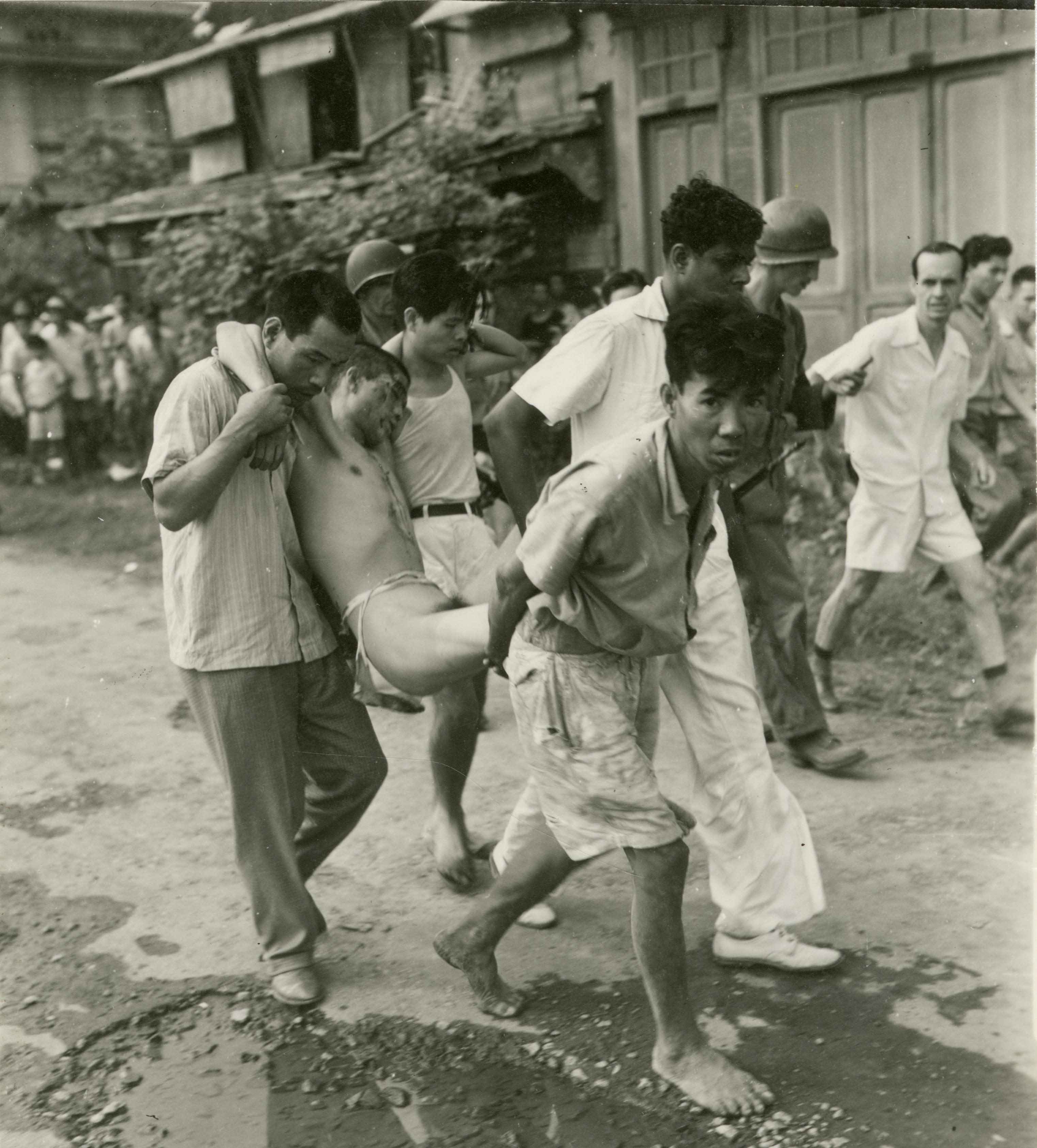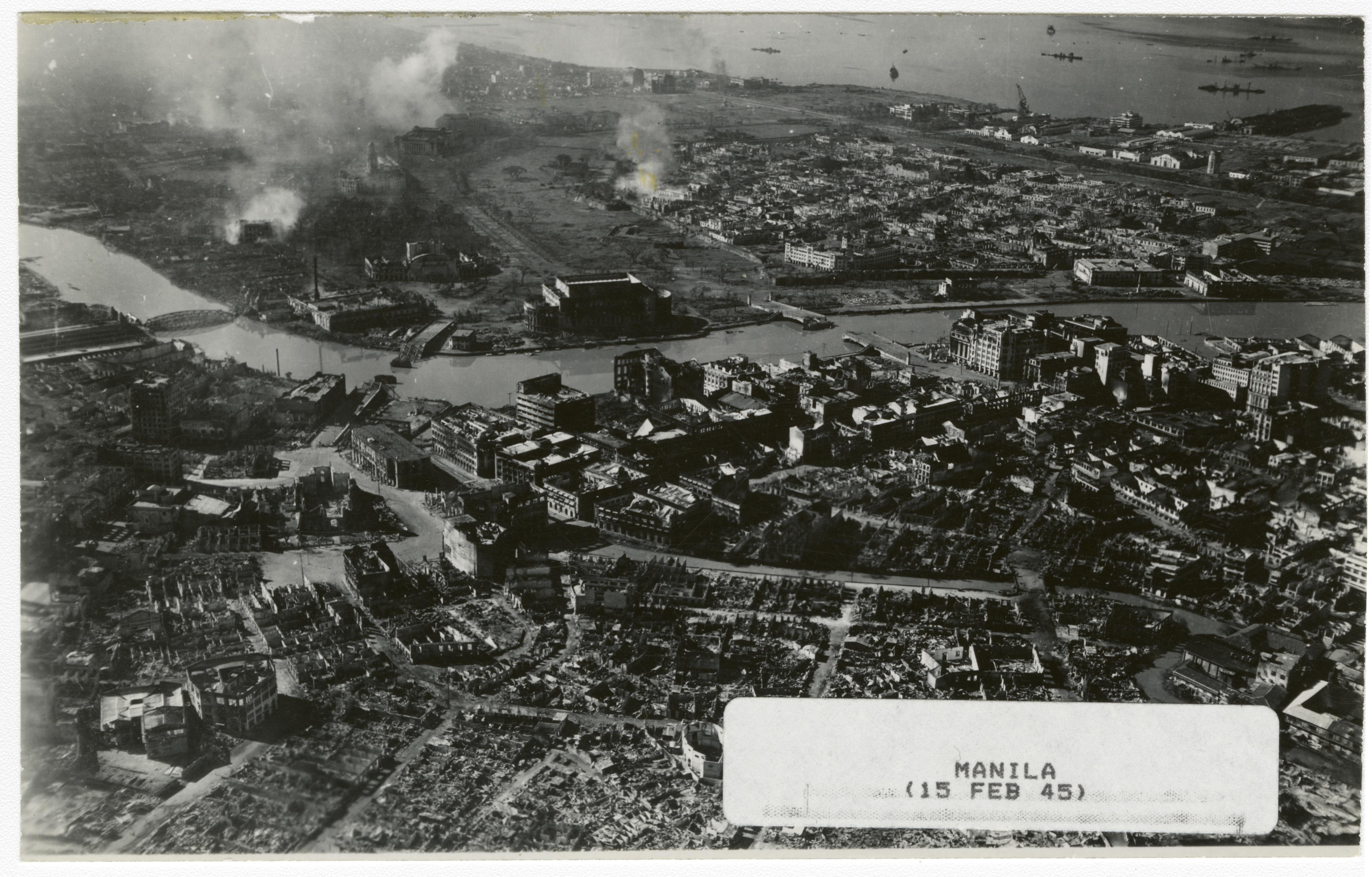Rampage: MacArthur, Yamashita, and the Battle of Manila tells the story of one of the most brutal chapters in the history of World War II. It is a meticulously researched account of the liberation of Manila in February 1945. The author, James M. Scott (Target Tokyo and The War Below), describes in detail the horrific crimes committed by the Japanese as they murder, rape, and destroy Manila, a city so beautiful it was once known as “the Pearl of the Orient.” While the violence is graphically described and at times is difficult to read, Scott does an excellent job of describing the atrocities and documenting Japanese crimes. It is a story unlike any other which occurred in the Pacific theater of the war, gritty urban warfare set in a large, progressive, modern city.
Rampage begins with Douglas MacArthur, standing on the porch of his cottage on the Philippine Island of Corregidor, preparing for the evacuation to Australia with his wife and son on the night of March 11, 1942. The Japanese entered Manila on January 2, 1942, and terror was rife throughout the city. American civilians and Filipinos feared the worst; Pacita Pestano-Jacinto described in her diary what everyone was thinking: “Now danger will not come from the skies, new danger will be living among us. With us.” The author uses countless journals and diaries, from Filipinos, Americans, US soldiers, and Japanese soldiers when describing the events which took place in Manila in February of 1945. The number of journals and diaries that our cited in Rampage are countless. It clearly illustrates a fresh and much- needed approach to a difficult subject. It is these firsthand accounts which bring the events which took place, as described in Rampage, alive.
The situation deteriorated rapidly with the Japanese occupation of Manila. The Japanese attempted to convince the public the Americans had lost the war. They launched a propaganda campaign which included theaters playing films showing Pearl Harbor, Bataan, and Corregidor. The economy of the once great city began to collapse, businesses closed, and public schools were reduced to a fraction of what they once were. It became very clear the Japanese made no effort to maintain the infrastructure of Manila. Juan Labrador, a Spanish priest, wrote in his dairy, “City life has become polluted by a swarm of parasites: doctors without patients, lawyers without clients, teachers without schools.” Eventually starvation sets in; people do whatever is necessary to survive. Children were abandoned or even sold. All of this is told in graphic detail. The University of Santo Tomas was established as an internment camp, where, for nearly three years over 4,000 foreign nationals, including Americans, were held captive here. As on the streets of Manila, the situation deteriorated rapidly inside the camp.
The reader is pulled in to the suffering being inflicted upon the population of Manila, constantly hoping that the US Army will arrive and end all the suffering, that the city will be liberated, and that life will continue. However, as we know well, this is not what happens.
On October 20, 1944, over two years after MacArthur fled Corregidor, the General returned to the Philippines. The Japanese did not intend to surrender Manila. On September 25, 1944, General Tomoyuki Yamashita was given command of all ground forces in the Philippines; however, as Scott explains, the Japanese command structure in the defense of Manila involved several commanding officers from the Army and Navy. In addition to Yamashita, Admiral Okochi, General Yokoyama, and Rear Admiral Sanji Iwabuchi were all players in the defense of Manila. Admiral Okochi ordered Rear Admiral Iwabuchi to destroy the port, harbor, and bridges. Yokoyama agreed with Okochi, and placed the army forces in Manila under the command of Iwabuchi. Yamashita moved his headquarters to the mountain town of Baguio, 125 miles north of Manila.
Iwabuchi had under his command 12,500 sailors and 4,500 soldiers, and against orders made the decision to defend Manila house-to-house. Troops constructed barricades out of cars and trucks, built pillboxes, laid mines along roads, and barricaded streets at intersections. They also filled windows with reinforced concrete, made gun slits in walls, and stashed ammunition in strategic places. The Japanese press wrote “Here on these islands in the vast Pacific Ocean, a great tragedy is about to occur. This is going to be a fight to the death.” Pacita Pestano-Jacinto wrote in her diary, “Defeat is the one thing that can make them turn into beasts.”
Elements of the US 5th Cavalry arrived at the Santo Tomas internment camp on the evening of February 3, 1945. There is jubilation and celebration inside the camp with the arrival of the Americans. Starving people are fed, although it proved too much for most and made them sick. Medical attention is applied to those in need. Outside the camp, the slaughter and destruction of the Pearl of the Orient has begun. In full detail we get the descriptions of the assaults at San Juan de Dios Hospital, the Santo Domingo Church, and the German Club. Japanese soldiers gang rape thousands of women, bayonet babies, chop off heads, and set the city on fire. Intramuros, the historic walled city within Manila, would be one of the last places the Japanese would hold out. Here, Sancho Enriquez hid his family in a shelter, where, after his wife came back to find water discovered “the mutilated bodies of our four children almost beyond recognition.”
There are stories of heroism. One of the strongpoints which the Japanese defended was the Paco Railroad Station. Three hundred Japanese marines had turned the old railroad station into a fortress. It was the job of the 148th Infantry to eradicate the Japanese from their stronghold. After a day of probing, the US soldiers were unable to penetrate the resistance and the tough fortifications. Privates Cleto Rodriquez and John Reese found a weak spot in the fortifications and exploited it. They kept moving forward and in a period of over two hours killed more than 80 Japanese and made it possible for the position to be taken by the US Army. Reese was killed and both men were later awarded the Medal of Honor.
Anyone south of the Pasig River was trapped by the constant crossfire of Japanese and American artillery. The author points out the decision to use US artillery did not come easily. MacArthur wanted to save as much of the city as he possibly could. At the same time, US commanders were more concerned about saving the lives of American soldiers. The US war correspondent and author, John Dos Passos, wrote, “It was like a bowling alley over our heads, guns shooting first from one side then from another.” More than one Filipino after the battle blamed the Americans for destroying their city with artillery.
The last stronghold held by the Japanese was the Agriculture Building and it was there where Iwabuchi held up. He realized surrender was not an option; with a knife he “slit open his belly.” On March 3 the Battle of Manila was over. The destruction of Manila was complete and its consequences would last for generations. Yamashita was tried by a military tribunal and on February 23, 1946, was hung.
What conclusion can we drawn from Rampage? Perhaps it is that the violence we associated with the end of World War II in the Pacific was not confined merely to Iwo Jima, Okinawa, the firebombing of Tokyo, or the atomic bombs. Manila began 1945, the final year of the war, as one of the most brutal chapters in the history of the war. Scott’s conclusion is that Manila has never recovered from that dreadful February in 1945. The ancient walled city lay in ruins, the reconstruction of the city was concentrated south of the city at Makati, and where the German club once was is now an empty field. In 1995, on the fifth anniversary, a statue was sculptured by Peter de Guzman, commemorating those who lost their lives. It is a very poignant reminder that those who were killed were innocent civilians, among them women and children.
Rampage is not a pleasant read; however, it is an historical account of one of the most horrific chapters in the history of World War II. It is well-documented and includes a selected bibliography and index. The photographs in the book bring to life the atrocities committed by the Japanese during that horrible February of 1945. This is not a read for the faint of heart, but it does provide a poignant and accurate account of the Battle for Manila and the barbarity of which man is capable.
Dan Olmsted
Cite this article:
MLA Citation:
APA Citation:
Chicago Style Citation:







![Max Fuchs, New York City cantor, sings as Rabbi Sydney [sic] Lefkowitz, Richmond, VA, conducts the first Jewish services from Germany.](/sites/default/files/styles/max_650x650/public/2025-10/image1.jpg)



